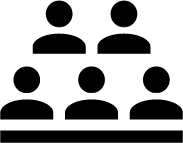It’s no secret that technology is constantly evolving, and when it comes to the trade show realm, it’s more important than ever to stay on top of the latest and newest tech trends in the industry. Technology plays a big role in how your audience engages with your trade show booth, and your ability to reel them in and keep them interested in what you have to say can make or break the event. Here are five new trade show booth tech trends we’re expecting to see in 2019.
Radio frequency identification (RFID)
RFID uses radio-frequency waves to wirelessly transfer data through a tag that can be embedded (in name badges, wristbands, plastic cards, etc.) in order to collect data. RFID can be used at trade shows in several ways: to check in attendees before an event or speaking session; as virtual credit cards (many trade shows have gone ‘cashless’ in recent years) that can be put into Apple Pay/Google Pay for faster payment transactions; and as a way for attendees to interact with sponsors and other attendees through live polling and surveys.
There are several great benefits to utilizing RFID technology at a trade show, including faster attendee check-in, immediate data on foot traffic, easier badge scanning and the ability to go completely cashless. RFID also allows for higher levels of engagement between attendees and event organizers.
Virtual Reality (VR)
In 2018, we really saw the virtual reality trend take off as an innovative and engaging way for attendees to interact during an event. VR is now being leveraged as a digital enhancement strategy to elevate the attendee experience with unique technology advances that they may not have access to in their everyday lives.
For instance, a VR headset allows participants to engage with 360 degrees 3D images, immersing them in places and experiences that are otherwise inaccessible; VR technology is also being used during large-scale trade shows for interactive demonstrations of vendors’ products that would otherwise be difficult to bring on-site. The possibilities for VR at trade shows are truly endless, and we’re excited to see what new trends pop up this year.
Engaging Live Demonstrations
When it comes to walking the show floor, trade show attendees are oftentimes faced with sensory overload, which can lead to a diminished attention span. A great way to combat this and stand out from the crowd is to facilitate the learning experience for them. Remember why people come to a trade show in the first place: they want to see, touch and experience the product, and they want to ask specific questions relevant to their situation. In a nutshell, the experience and information have to be different and deeper than what they can find on your website.
Showing and teaching in real time, alongside engaging digital content, will be a big trend in 2019. Delivering information your customer needs to know in the most relevant, impactful, and meaningful way will be a big goal for trade show presenters this year.
Artificial Intelligence (AI)
AI has become the event technology buzzword within the past year, and for good reason! AI has enhanced the personalization of the attendee experience with more meaningful interactions and is now being used as a matching engine to pair attendees with activities or experiences that align with their own interests and goals for the event. This savvy matching capability allows for more impactful interactions between attendees, exhibitors, and sponsors which, in turn, is allowing exhibitors and sponsors to better understand the unique interests of their audience.
Facial Recognition
At a number of shows in the past year, we’ve seen cameras and large screens showing the markers on faces of passersby as they count and register the number of attendees in the given area. Some examples would measure mood and on-screen graphics would change color depending on your facial expression. To those who’ve never experienced this before, it does make people stop and take notice. Other companies are using this same technology without showing it off to measure their potential impact at the show. We think that this trend will continue in the future.
Creative Lighting
Visual stimulation has been a key component of trade show marketing for years; however, as technology develops and consumers become accustomed to more and more sophisticated experiences, visual communication needs to be more than signage and flat-screen TVs. We predict that this year, we’ll be seeing brands use lighting and visual elements in new and creative ways, recognizing the power to not only attract attention but to direct that attention to specific products or information. 3D projection mapping is a great example of this – it allows you to completely transform any size space using light and projectors.




